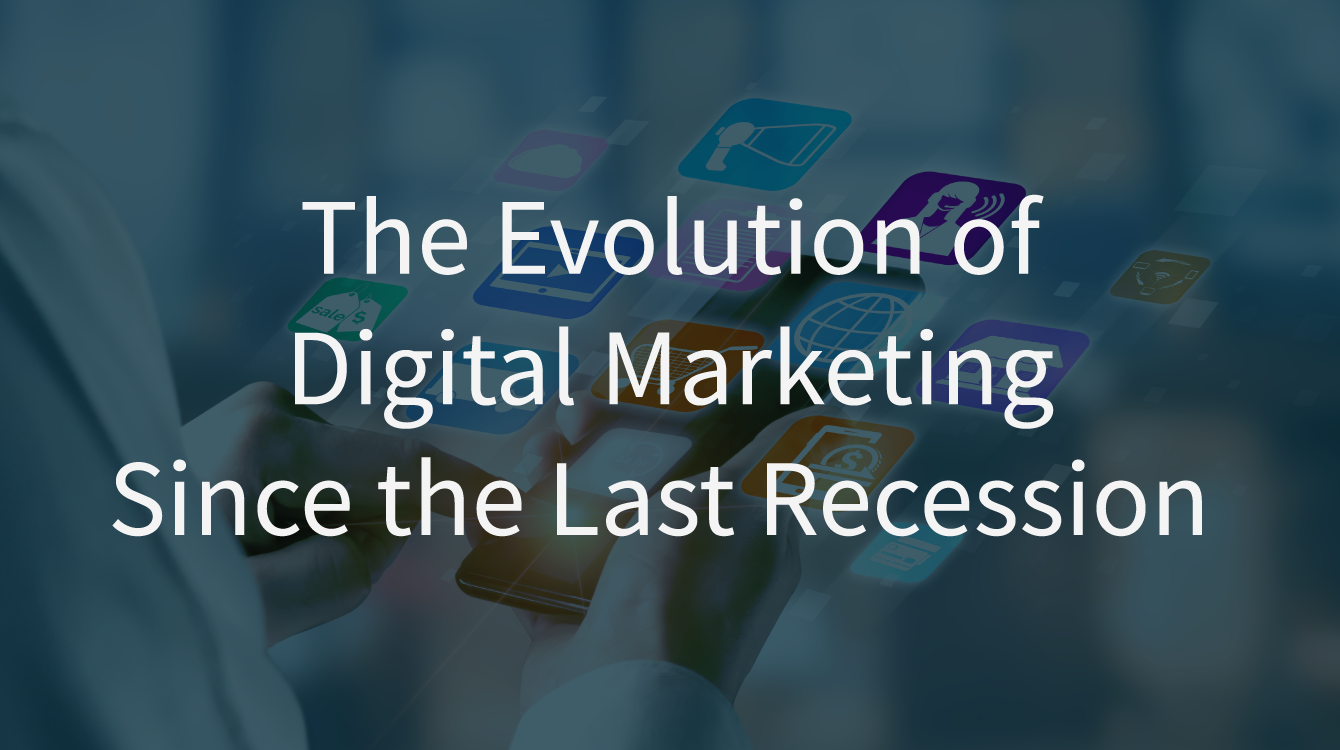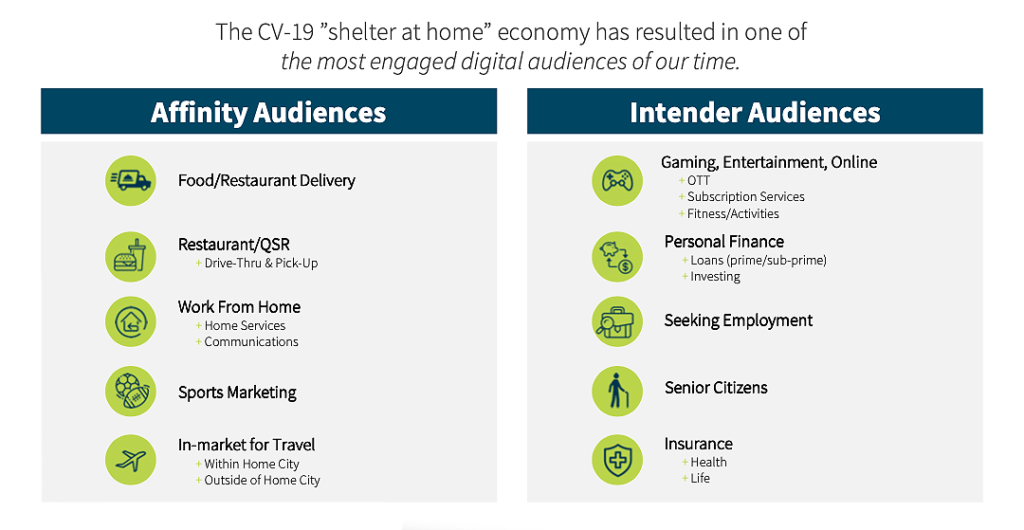
Articles | June 25, 2020 | 3 min read
The Evolution of Digital Marketing Since the Last Recession
Things have changed in digital marketing since the last recession.
As a matter of fact, they’ve changed a lot.
That’s good news for brands still looking to resonate with prospective and current customers. Especially given the uniqueness of this recession and its neutralization of the more “traditional methods” of marketing:
With that said, here are all the ways things have gotten better in digital marketing since the last recession.
In marketing, the pressure is always on to maximize ROI. But when a recession hits, that pressure rises to a whole new level. The easiest way to maximize ROI is through the deployment of scalable campaigns that target specific individuals within high-value audiences.
During the 2007-09 recession, creating campaigns like this wasn’t possible.
Fortunately, advancements in data collection, analysis, and artificial intelligence now make it possible for brands to unlock affinities, recognize intents, and personalize their messaging to the individual consumer.

The key to personalization at scale lies in knowing the affinities, intents, and content consumption trends of individuals (be they prospects, current customers, or churned customers). During the last recession, obtaining this information in an expedient, cost-effective way wasn’t possible.
But today it is, and it’s having a huge impact on brands effectiveness with marketing. Why? Because personalization is the cornerstone of modern marketing success (and is used in the best digital marketing campaign examples).
During the last recession, assessing the reality of the customer journey in real-time was, at best, cumbersome and, at worst, not even possible. Not so in today’s market thanks to advancements in data collection, aggregation, and AI. Now things like content consumption signals associated with unique identities can be measured on a regular basis. This allows for the creation of dynamic audience clusters, micro-audiences, and individual IDs ready for marketing engagement.
The consumer access offered through digital marketing is jaw-dropping compared to where it was in 2007 when the Great Recession started. Emerging technologies (like Connected TV) coupled with overarching strategic advancements like 1:1 omnichannel activation, empower brand marketers like never before, allowing them to reach specific consumers (e.g. New York Jets fans living in Staten Island who like to shop at Bed, Bath and Beyond) across every channel (e.g. display, social, email, Connected TV, etc.) and every device at any time.
Digital is in a better position to help brands achieve positive business outcomes during this coronavirus-sparked recession than it was during the Great Recession.
Not only do people spend more time online than they did 13 years ago, but their consumption of digital content has soared. Today’s consumers consider digital tools (smartphones, smart speakers, connected TVs, etc.) and digital content (Netflix, YouTube, etc.), not as luxuries, but as indispensable utilities.
But most importantly, digital isn’t just stronger in terms of consumer penetration (i.e. how consumers use the internet), it’s also stronger in terms of what it allows marketers to do.
As a matter of fact, they’ve changed a lot.
That’s good news for brands still looking to resonate with prospective and current customers. Especially given the uniqueness of this recession and its neutralization of the more “traditional methods” of marketing:
- Billboards, event sponsorship, transit wraps, and POS displays can’t be effective marketing solutions when people spend almost every waking hour of the day inside.
- Flyers, self-mailers, postcards, and catalogs can’t bring new customers in the front door if consumers—hyper-sensitive to hygiene thanks to COVID-19—throw their mail straight into the trash.
- Expensive, unaddressable, and with an ever-dwindling reach, linear TV will be a sub-optimal marketing medium for the remainder of this recession.
- Print marketing will be a no-go for the remainder of the year, as consumers shy away from newspapers and magazines due to heightened healthcare concerns.
With that said, here are all the ways things have gotten better in digital marketing since the last recession.
Accuracy
In marketing, the pressure is always on to maximize ROI. But when a recession hits, that pressure rises to a whole new level. The easiest way to maximize ROI is through the deployment of scalable campaigns that target specific individuals within high-value audiences.
During the 2007-09 recession, creating campaigns like this wasn’t possible.
Fortunately, advancements in data collection, analysis, and artificial intelligence now make it possible for brands to unlock affinities, recognize intents, and personalize their messaging to the individual consumer.

Personalization
The key to personalization at scale lies in knowing the affinities, intents, and content consumption trends of individuals (be they prospects, current customers, or churned customers). During the last recession, obtaining this information in an expedient, cost-effective way wasn’t possible.
But today it is, and it’s having a huge impact on brands effectiveness with marketing. Why? Because personalization is the cornerstone of modern marketing success (and is used in the best digital marketing campaign examples).
- 78% of consumers will engage with a brand’s offer if that offer is personalized based on a previous brand engagement.
- 59% of consumers say personalization plays a major role in shaping their buying decisions, with industry experts suggesting that influence can drive a 30% uplift in revenue and retention.
Measurement
During the last recession, assessing the reality of the customer journey in real-time was, at best, cumbersome and, at worst, not even possible. Not so in today’s market thanks to advancements in data collection, aggregation, and AI. Now things like content consumption signals associated with unique identities can be measured on a regular basis. This allows for the creation of dynamic audience clusters, micro-audiences, and individual IDs ready for marketing engagement.
Access
The consumer access offered through digital marketing is jaw-dropping compared to where it was in 2007 when the Great Recession started. Emerging technologies (like Connected TV) coupled with overarching strategic advancements like 1:1 omnichannel activation, empower brand marketers like never before, allowing them to reach specific consumers (e.g. New York Jets fans living in Staten Island who like to shop at Bed, Bath and Beyond) across every channel (e.g. display, social, email, Connected TV, etc.) and every device at any time.
The thing you need to remember about digital marketing since the last recession?
Digital is in a better position to help brands achieve positive business outcomes during this coronavirus-sparked recession than it was during the Great Recession.
Not only do people spend more time online than they did 13 years ago, but their consumption of digital content has soared. Today’s consumers consider digital tools (smartphones, smart speakers, connected TVs, etc.) and digital content (Netflix, YouTube, etc.), not as luxuries, but as indispensable utilities.
But most importantly, digital isn’t just stronger in terms of consumer penetration (i.e. how consumers use the internet), it’s also stronger in terms of what it allows marketers to do.


